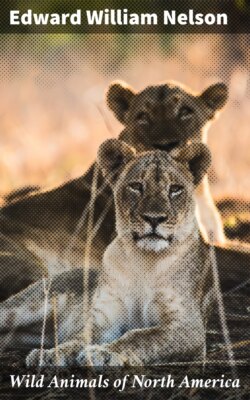Читать книгу Wild Animals of North America - Edward William Nelson - Страница 23
На сайте Литреса книга снята с продажи.
JAGUAR (Felis hernandesi and its subspecies)
ОглавлениеTable of Contents
The jaguar, or “el tigre,” as it is generally known throughout Spanish America, is the largest and handsomest of American cats. Its size and deep yellow color, profusely marked with black spots and rosettes, give it a close resemblance to the African leopard. It is, however, a heavier and more powerful animal. In parts of the dense tropical forests of South America coal-black jaguars occur, and while representing merely a color phase, they are popularly supposed to be much fiercer than the ordinary animal.
Jaguars are characteristic animals of the tropics in both Americas, frequenting alike the low jungle of arid parts as well as the great forests of the humid regions. In addition, they range south into Argentina and north into the southwestern United States. Although less numerous within our borders than formerly, they still occur as rare visitants as far north as middle Texas, middle New Mexico, and northern Arizona. They are so strictly nocturnal that their presence in our territory is usually not suspected until, after depredations on stock usually attributed to mountain lions, a trap or poison is put out and reveals a jaguar as the offender. Several have been killed in this way within our border during the last ten years, including one not far from the tourist hotel at the Grand Canyon of Arizona.
Although so large and powerful, the jaguar has none of the truculent ferocity of the African leopard. During the years I spent in its country, mainly in the open, I made careful inquiry without hearing of a single case where one had attacked human beings. So far as I could learn, it has practically the same shy and cowardly nature as the mountain lion. Despite this, the natives throughout its tropical home have a great fear of “el tigre,” as I saw evidenced repeatedly in Mexico. Apparently this fear is based wholly on its strength and potential ability to harm man if it so desired.
Jaguars are very destructive to the larger game birds and mammals of their domain and to horses and cattle on ranches. On many large tropical ranches a “tigrero,” or tiger hunter, with a small pack of mongrel dogs, is maintained, whose duty it is immediately to take up the trail when a “tigre” makes its presence known, usually by killing cattle. The hunter steadily continues the pursuit, sometimes for many days, until the animal is either killed or driven out of the district. It is ordinarily hunted with dogs, which noisily follow the trail, but its speed through the jungle often enables it to escape. When hard pressed it takes to a tree and is easily killed.
Few predatory animals are such wanderers as the jaguar, which roams hundreds of miles from its original home, as shown by its occasional appearance far within our borders. In the heavy tropical forest it so commonly follows the large wandering herds of white-lipped peccaries that some of the Mexicans contend that every large herd is trailed by a tiger to pick up stragglers. Along the Mexican coast in spring, when sea turtles crawl up the beaches to bury their eggs in the sand, the rising sun often reveals the fresh tracks of the jaguar where it has traveled for miles along the shore in search of these savory deposits.
In one locality on the Pacific coast of Guerrero I found that the hardier natives had an interesting method of hunting the “tigre” during the mating period. At such times the male has the habit of leaving its lair near the head of a small canyon in the foothills early in the evening and following down the canyon for some distance, at intervals uttering a subdued roar. On moonlight nights at this time the hunter places an expert native with a short wooden trumpet near the mouth of the canyon to imitate the “tigre’s” call as soon as it is heard and to repeat the cry at proper intervals. After placing the caller, the hunter ascends the canyon several hundred yards and, gun in hand, awaits the approach of the animal. The natives have many amusing tales of the sudden exit of untried hunters when the approaching animal unexpectedly uttered its roar at close quarters.
